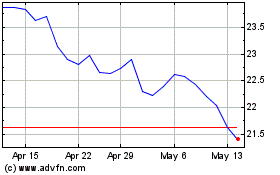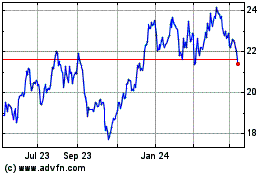Australia Stocks May Recover After Near-15% Decline Last Year
03 January 2012 - 6:09PM
Dow Jones News
Australian shares sank more than European stocks last year, but
investors say they could be headed for a revival as interest rate
cuts get consumers spending and a global economic recovery
intensifies.
The benchmark S&P/ASX 200 completed the first consecutive
annual decline in its 20-year history in 2011 as domestic and
global headwinds shattered local investor confidence. Its near-15%
slump to end the year at 4056.6 was greater than the 11% fall in
the Stoxx Europe 600 Index, which was weighed down by that region's
sovereign debt crisis. In the U.S., the S&P 500 was virtually
unchanged.
"Australian stocks are looking very cheap right now," said Shane
Oliver, head of investment strategy at AMP Capital Investors, who
helps manage close to US$100 billion from Sydney. "The market
should recover next year as it becomes clear the global economy
isn't going into free fall, and as rate cuts in Australia reach a
critical mass."
In addition to Europe's problems, Australian investors' faith in
a global recovery was hurt by patchy U.S. economic data, several
natural disasters, and tighter monetary policy in China, the
destination for much of Australia's raw-materials exports.
At home, manufacturers were hit by a surging Australian dollar,
while retailers and banks struggled as the country's interest
rates, still among the highest in the developed world, crimped
consumer spending.
In August, the S&P/ASX 200 entered what some investors call
a bear market after Standard & Poor's cut the U.S. credit
rating. That news rocked markets globally, although U.S. shares
have held up on optimism an economic recovery there is intact.
While Australian shares may struggle early in 2012 as some of
last year's issues continue to play out, the market should recover
in the latter half as a global recovery is confirmed, investors
say.
There are already signs growth is picking up--a survey Tuesday
showed Australian manufacturing expanding for the first time in six
months, while earlier German and Chinese factory output reports
beat economists' estimates.
On the Sydney bourse, BHP Billiton Ltd. (BHP) and Rio Tinto PLC
(RIO) tumbled 24% and 29% in 2011, respectively, on concerns
commodities demand will wane as austerity programs leave European
nations cash-strapped. The mining giants also suffered from
speculation China's anti-inflation policies may lead to a hard
landing for its economy.
Australia's central bank in December cut interest rates for the
second straight month citing concern over the fall-out from
Europe's crisis, although worry about a Chinese slowdown
lessened.
Australian manufacturers suffered last year as the dollar
hovered near parity with the U.S. currency after a near-40% gain
since 2008. BlueScope Steel Ltd. (BSL.AU) dropped 79%, while
Cochlear Ltd. (COH.AU), which sells hearing implants overseas, lost
almost a quarter of its value.
Companies with a heavy U.S. presence--including James Hardie
Industries SE (JHX.AU) and Brambles Ltd. (BXB.AU)--were among the
few to climb as that nation's economic prospects looked like
improving in the June-December period.
While the order of declines was less than in the resources
sector, financial shares--including Westpac Banking Corp. (WBC.AU)
and National Australia Bank Ltd. (NAB.AU)--retreated as the
nation's high interest rates encouraged people to save.
That had a knock-on effect on retailers such as JB Hi-Fi Ltd.
(JBH.AU) and Billabong International Ltd. (BBG.AU)--both of which
issued profit warnings recently. JB Hi-Fi lost 37% of its value in
2011, while Billabong shed close to 78%.
"Rather than progressive improvements in economic conditions, as
most anticipated, we saw an intensification of the economic
headwinds in 2011," says Angus Gluskie, managing director of White
Funds Management in Sydney.
Still, last year's drop pales in comparison with the S&P/ASX
200 index's 41% decline in 2008 in the midst of the credit crisis.
The benchmark gauge recovered 31% in 2009 as governments pumped
money to stimulate their economies.
-By Shani Raja, Dow Jones Newswires; +61-2-82724683; shani.raja@dowjones.com
Bluescope Steel (ASX:BSL)
Historical Stock Chart
From Feb 2025 to Mar 2025

Bluescope Steel (ASX:BSL)
Historical Stock Chart
From Mar 2024 to Mar 2025
